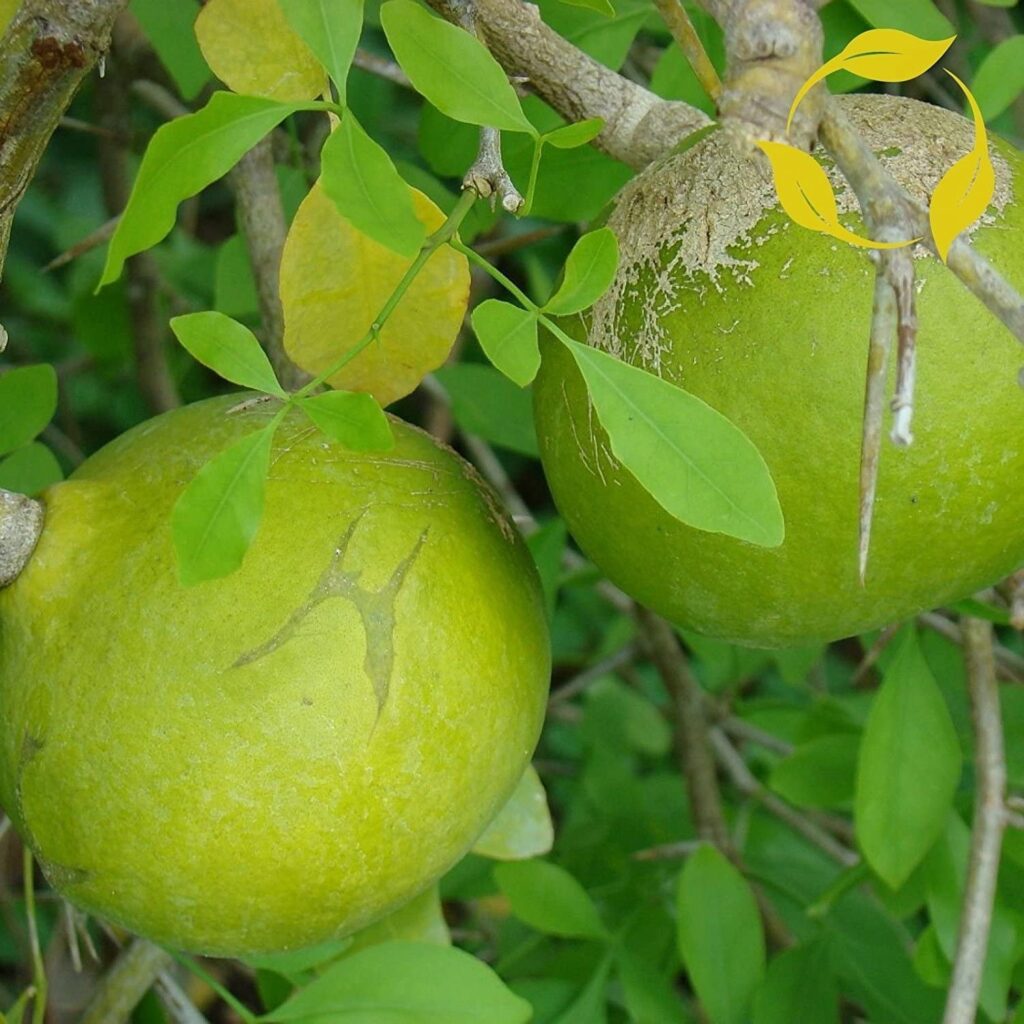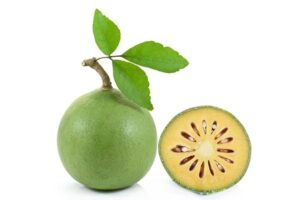Herb
Bilva (Aegle marmelos) Herb Ayurvedic Overview
Bilva (Aegle marmelos) is a spinous, aromatic, straight, robust, and axillary tree that grows up to 18 meters tall and bears long thorns. It consists of the pulp of entire, unripe, or half-ripe fruits of Aegle marmelos Carr. (Fam. Rutaceae). It is cultivated throughout the country. The leaves are usually 3-foliate, ovate-lanceolate, lateral sessile, terminal long-petioled. The flowers of Bilva (Aegle marmelos) are greenish-white, sweet-scented, axillary, and have panicles. The fruits have approximately 15 cm diameter, 8-16 celled, globose, and greyish-yellow. Bilva fruit is a very widespread plant native to India, Sri Lanka, and Bangladesh.
Bilva fruits are famous for their anti-inflammatory, antioxidant, laxative, cardiotonic, and astringent properties and have been used for various therapeutic properties for thousands of years. The fruit is very commonly used for digestive disturbances. The unripe fruit stimulates indigestion and balances Vata and Kapha in the body. In Hinduism, the leaves of Bilva or Bael are considered unusually spiritually charged Hinduism and are said to reverberate with Sattvik Energy.
Bilva (Aegle marmelos) rich in various nutritional properties, thus strengthening the immune system and fights multiple infections, diseases, and other health disorders. The presence of multiple antioxidants, phytochemicals, phenolic compounds, nutrients, and flavonoids in Bilva make it a very healthy and nutritious remedy. The root effectively balances Tridosha and is mainly used in ulcerative colitis, abdominal pain, stomach cramps, excess vomiting, indigestion, etc. Other than this, it relieves sinusitis, gastritis, dyspepsia, chronic diarrhea.
Table of Contents
Scientific Classification of :
- Kingdom: Plantae
- Subkingdom: Tracheobionta
- Division: Magnoliophyta
- Class: Magnoliopsida
- Subclass: Rosidae
- Order: Sapindales
- Family: Rutaceae
- Genus: Aegle
- Species: marmelos
Bilva (Aegle marmelos) Synonyms:
- Sanskrit: Sriphala
- Assamese: Bael, Vaela
- Bengali: Bela, Bilva
- English: Bengal Quince, Bael fruit
- Gujrati: Bill, Bilum, Bilvaphal
- Hindi: Bela, Sriphal, Bel
- Kannada: Bilva
- Kashmiri: Bel
- Malayalam: Koovalam
- Marathi: Bel, Baela
- Oriya: Bela
- Punjabi: Bil
- Tamil: Vilvam
- Telugu: Maredu
- Urdu: Bel
Bilva (Aegle marmelos) Description:
a) Macroscopic: The Bilva Fruit is sub-globose, having 5-18 cm in diameter. Externally it is greenish when young, yellowish-brown when ripe. The rind is about 1.5 mm-3 mm thick, hard and woody. The surface is smooth or slightly granular, bearing a circular scar at the point of attachment with the peduncle—each carpal containing several hairy seeds embedded in yellowish-brown and has extremely sticky mucilage. The five petals are blunt, thick, oblong ovoid, pale greenish-white, and dotted with oil glands.
The seeds of Bilva (Aegle marmelos) are oblong, flat, woody, and having white hair, and are arranged in the cells that are surrounded by a slimy transparent mucilage. The fresh pulp of ripe fruit is brown and having moist shreds. The dried pulp is hard and pale to dark red; frequently, while drying, the pulp breaks away from the rind and leaving a thin layer attached to it. The odor is faintly aromatic; the taste is mucilaginous and slightly astringent.
Identity, Purity, and Strength of Bilva (Aegle marmelos):
- Total Ash Not more than 4 percent, Appendix 2.2.3.
- Acid-insoluble ash Not more than 1 percent, Appendix 2.2.4.
- Alcohol-soluble extractive Not less than 6 percent, Appendix 2.2.6.
- Water-soluble extractive Not less than 50 percent, Appendix 2.2.7.
Chemical Constituents of Bilva (Aegle marmelos):
The main constituents of Bilva are Marmalosin, tannins, saponins, alkaloids, phenol, terpenoids, mucilage, fatty oil, etc.
Ayurvedic Properties and Action of Bilva (Aegle marmelos):
- Rasa: Katu, Tikta, Kshaya
- Guna: Laghu, Ruksha
- Virya: Ushna
- Vipaka: Katu
- Karma: Deepan, Pachan, Grahi, Balaya, Vatakaphahara, Sangrahi, Shoolaghan, Amaghan, Agnivardhak.
Ayurvedic Formulation made by Bilva (Aegle marmelos):
The Ayurvedic Formulations made by Bilva (Aegle marmelos) are Bilvadi Leha, Brihat Gangadhara Churan, Kuataj Avaleha, Vilwadi Gulika.
Therapeutic Uses of Bilva (Aegle marmelos):
Bilva or Bael effectively works in Pravahika, Agni mandaya, Vamighana, Shoolaghana, Grahani Roga.
Dose of Bilva (Aegle marmelos):
3-6 gm of the drug in powder form.
Reference:
Ayurvedic Pharmacopeia of India.



